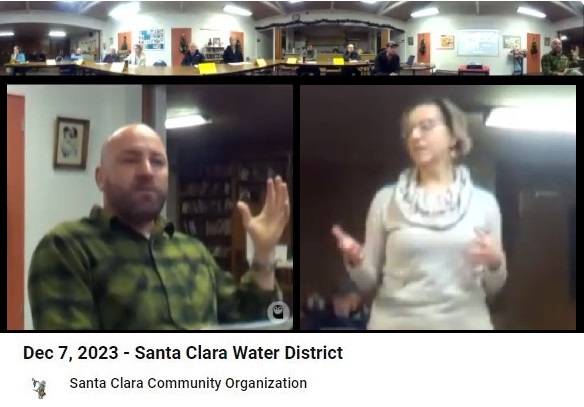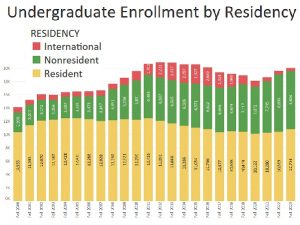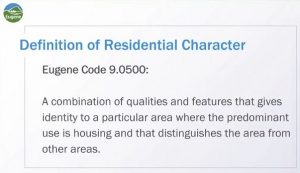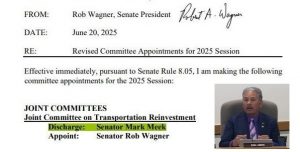Water district, EWEB partner to serve Santa Clara
9 min read
Santa Clara’s water district and EWEB explain how they serve the community, both today and in the event of an emergency. At the Santa Clara Community Organization Dec. 7:
Eric Carlson (Santa Clara Water District): I’ve been on the Santa Clara Water District. I’m on my fifth year. I’m currently serving as the board chair. I work for Rainbow Water District in Springfield, so water districts and water is something I’m passionate about, and I thought it would be great for me to help out my local community.
A special district is a local government that has a very narrow or single focus, and ours is a domestic water service. Special districts are kind of unique to the West Coast. There are some further east but the West Coast, it’s very common to have, especially in the northwest, these special districts. They could be anything from a fire district, water district, sewer district, there’s parks, busing districts, like 30-something different types of districts there could be.
[00:00:54] Santa Clara Water District was formed in 1955. Residents of Santa Clara at the time petitioned Lane County to give a boundary and then it went out for election in July of 1955, and August there’s a Register-Guard article saying that it was approved.
[00:01:15] My guess is city services didn’t extend out this far. And so Santa Clara was mostly rural. 1955 was before any of these subdivisions went in, and my guess is there was some communities that went together—some members went together on either a well or multiple wells to serve the area as a whole. That’s just a guess.
[00:01:35] We’re managed by five elected board members. Santa Clara has no employees, and we have no real property. We don’t have any pumping infrastructure. What we do have are pipelines and fire hydrants, and unfortunately, streetlights. Streetlights are our nemesis.
[00:01:53] I don’t understand why the district has the streetlights. Only thing I can come up with is that no one else wanted them, and somehow we ended up with them as part of fire protection or something like that, I don’t know. I hate the streetlights. We spend more time talking about streetlights than we talk about water with the district.
[00:02:15] Our contract to service those streetlights: We just recently entertained an option to contract with the city of Eugene to handle the streetlights. Looks like it’s going to be a wash as far as cost-wise, but our customers will get better service.
[00:02:31] We do have an accountant that we contract with, Warren and Associates. He attends all of our board meetings and handles our financials.
[00:02:39] Santa Clara, basically all we do is we set the rate for what you guys pay for water. So when you see your EWEB bill, the water section is the only thing that we control. There’s other sections, as you guys know, for sewer, stormwater services, power, we have nothing to do with that. We just focus on the water side.
[00:03:01] We’re funded strictly through water sales, no taxes or levies. And we approve how money is spent. We approve projects, infrastructure projects that we’ve done. We typically do one- to two-year replacement pipeline projects and I’m very proud of our financial position.
[00:03:18] We have a budget of just under $5 million. $2.5 million of that is in the water infrastructure fund, another $2.5 million of that for the savings.
[00:03:28] Last year, 2022, our EWEB revenue was $1,974,000 and change, about $1,225,000 was just to EWEB for water sales. We also sent them another just under $400,000 for repairs that we did over the year.
[00:03:48] The $30,000, Warren and Associates for our accountant services. We spent $2,000 on legal costs, spent about $4,000 through EPUD for street lights. $7,000 through SCAO, which is our Special Districts Association (of Oregon).
[00:04:06] So we try to do our due diligence and spend our money in a responsible way.
[00:04:11] We do meet the first Tuesday of every month, over at the Santa Clara Fire District, 5 p.m.
[00:04:17] And now we’ll segue to Jeannine (Parisi), our EWEB liaison. She attends our board meetings. She’s our interaction between EWEB and ourselves. So, EWEB has projects they want to do or they think projects we should do. She brings them to us. We talk about it. We ask a lot of questions. Jeannine?
[00:04:37] Jeannine Parisi (EWEB): I thought I’d just give a little context about the partnership between EWEB and the Water District. Santa Clara is one of three special districts that EWEB works with. The River Road Water District is a little bit smaller than Santa Clara. We sell wholesale water to Willamette Water Company; they have a small system that serves Goshen, and then we’re their backup water source for the city of Veneta.
[00:05:01] EWEB, we provide wholesale water, we set a wholesale rate to the district, and then the district makes decisions about how much they charge customers. EWEB does not do that, that’s the district’s decision.
[00:05:13] EWEB does also act as your basic water utility maintenance organization. Anytime there’s anything that goes wrong with a meter, or a pipe, or something in the street that’s EWEB that responds to that. If there’s a water quality complaint, if the fire hydrant is leaking, or it gets hit by a car, those are all the kinds of things that EWEB does on behalf of the district, because like Eric said, there’s no staff.
[00:05:40] So, EWEB is essentially your contract water utility, we bill the district for all of that O&M. Most of your water system was built as you know, a lot of development out in this area in the ’60s and ’70s. And we’re getting to that period of time where some things start breaking down.
[00:05:57] And so we have been over the past five years really working very closely with the district to identify water main replacement because it’s expensive when you have a water main break and we have to send crews out in the middle of the night out to repair. So we want to, and then people are out of water, right, so depending on how big the break is, you could have anywhere from 10 to 30 people out of water for a period of time and nobody likes that. We all want our water to be delicious and available on tap 24-7. That’s our goal at EWEB.
[00:06:32] So we’ve been working with the district to identify strategic projects for (water) main replacements. And so, in 2019 through 2020, we went and did a water meter replacement project, and I think we touched probably 90% of every household in the district and put a new water meter in for you.
[00:06:52] We’ve done major water main upgrades—we did two and we’ve got one on the books. We’ll be working on Azalea this coming year. And then the district just agreed to start the planning and preparation work to do the water main on Myoak.
[00:07:08] Kate Perle (Santa Clara Community Organization): Is it both East and West Myoak?
[00:07:10] Jeannine Parisi (EWEB): This side—to the east of River Road. Because that’s where it kind of dead-ends and those dead end parts are usually not great.
[00:07:21] EWEB in general, we have about 200,000 customers that we serve. And we get our water from the beautiful McKenzie River, it goes to this treatment plant, our Hayden Bridge filtration plant is the single source of treatment. We send millions and millions of gallons of water through that treatment plant to homes in Eugene and Springfield through about 800 miles of pipe.
[00:07:44] Sixty miles of pipes belong to the district, so that’s your asset. We have about 54,000 connections that are meter connections that are EWEB customers, you all have about 4,635, and that goes down about every year as property is annexed. When property is annexed, those customers become EWEB customers, so they become city of Eugene. They transfer to EWEB.
[00:08:07] Sometimes that means we can get a hydrant. Sometimes, it’s just the property that is annexed.
[00:08:13] You have 210 hydrants in your system. The city of Eugene, it is a big hydrant owner. EWEB does not own the hydrants, the city does, they have about 4,500.
[00:08:24] So I would just say that this is a really healthy partnership. We support each other. I just go to the meetings and, actually, to be honest, it’s one of my favorite parts of my job. And I tell these guys this all the time, so I have a really great job at EWEB, but one of the things that I like the best is working with customers and working with volunteers because it’s kind of like, thankless work, right?
Not a lot of people even know that there’s a water district. They get a bill that looks like the EWEB bill, they have no idea that there is a committee of five people who are meeting and managing a budget and trying to make really good decisions on your behalf about water—which is essential, right. It is the most critical thing that we do as a public organization. And it’s just a pleasure for me to work with them.
[00:09:11] And I’ll just wrap up and change a bunch of questions.
[00:09:13] Kate Perle (Santa Clara Community Organization): Do we pay the same rate as city residents for water?
[00:09:17] Eric Carlson (Santa Clara Water District): We do not. The rate structure is very different. There’s some story behind this. Our rate structure is set that our base rate is much lower than the city residents, but our cost per 1,000 gallons is higher. And I asked the same question when I joined the board.
[00:09:37] And the reason for that is, is a number of our customers, throughout the history, have had private irrigation wells. And so it was more cost-effective for those customers to have that lower base rate so that their bill is lower throughout the whole year. Now, if you don’t have an irrigation well, in the summer months you will pay more, more likely, for that water usage. Winter months are typically cheaper.
[00:10:03] Santa Clara Community resident: Have you talked about any, like, emergency preparedness stuff?
[00:10:08] Jeannine Parisi (EWEB): Great question. So we have been working on building a second treatment plant on the Willamette River. So, we have water rights and we have property, but that plant is not yet built.
[00:10:19] And it’s a complicated project, it’s a $98 million dollar project. It’s probably the largest project that on the water side that EWEB has ever done. We hope to start that project in 2026.
[00:10:32] So for EWEB customers, part of that 8.3% (rate hike) is starting to build a bank account, so that we don’t have to go out for bonds and loan all of that money because that’s kind of very expensive for a very long time. So we’re trying to balance paying up front, and also bonds.
[00:10:50] So that plant’s not yet built. Because it takes so long to build that second treatment plant, and because we are worried that we are vulnerable with one treatment plant, one source of water, we have built emergency wells around the town.
[00:11:09] We have five well systems in town and kind of geographically distributed, mostly at schools. And then we’re in the process of building two more and what that is, is just for provisional water. So it means if for whatever reason we can’t provide water through our piping system, these are independent. They’re on wells and you can come to the well site and fill up two, three gallons of water for basic health and safety until we get the plant back up and running.
[00:11:39] So we have, the closest to you is at Howard Elementary School. So not too far away from you.
[00:11:46] We test the water (I think) once or twice a year, make sure water quality is good, but they’re just ready and waiting. And then there’s a storage container, and that’s full of all the equipment that we would need to basically set up a water distribution system. So we do drills on these every year, and if you’re ever interested, I just encourage you to come out, you can fill up a water container, and you can see what it looks like, and you can kind of practice what it would be like.
[00:12:14] The next (emergency well) will likely be at Amazon by the Roosevelt Middle School and the YMCA. That’ll probably be the next station that we build and every time we build one we kind of do a grand opening.
[00:12:30] John Q: The Santa Clara Water District and EWEB team up on an essential service, clean water. To learn more, visit the SCCO website, check out Ready NW, or stop in at a water district meeting.



